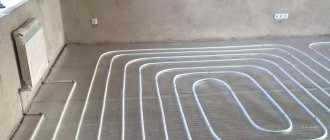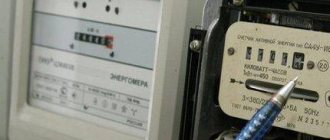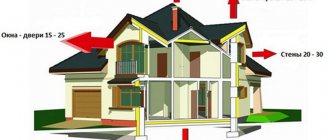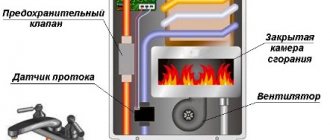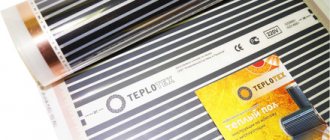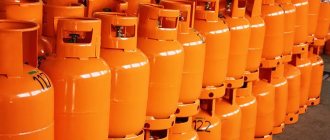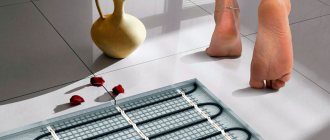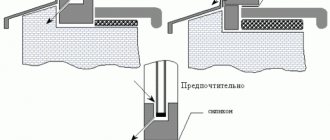Having decided to install a heated floor in an apartment or house, and having given preference to an electric device rather than a water one, you need to understand that in addition to installation costs, you will have constant costs for paying for electricity. Therefore, you need to calculate in advance how much electricity the warm floor will consume.
The article presents the characteristics of all models of electric floors, their advantages and disadvantages, as well as a comparative analysis of power consumption by each type.
In addition, we have tried to collect here all the advice from professionals that will help reduce the costs of operating these systems and save the family budget.
Types of electric heated floors
Today there is a huge range of electric flooring systems on the market. All of them are divided into several types.
Below we will analyze in detail the technical characteristics of each type, calculate the electricity consumption depending on the type of room per 1 m2 per hour, per month. We will also find out how the topcoat affects energy consumption.
Electrical cable
An electrical cable is a wire that is laid randomly, but more often in a “snail” or “snake” pattern. The structure is filled with a concrete screed on top, which reduces the height of the room by an average of 5 cm. The specific power of such a cable is from 0.01 to 0.06 kW/m2, its choice depends on the frequency of turns.
The energy intensity of one meter of cable ranges from 10 to 60 W. To cover 1 m2 of surface, about 5 meters of wire are required, thus heating on average requires 120 - 200 W of electricity.
Thermomat
Heating mats are a structure made of cable, which is laid according to a certain pattern on a special grid. It is often mounted under a screed and is perfect for installation in rooms with high humidity.
This model is intended for rooms with low ceilings, since the thickness of the “pie” is only 3 cm. The power of the mat is up to 0.2 kW/m2.
The average consumption per square meter of a heating mat is 120 - 200 W.
Infrared film
Infrared heated floor is a thin polymer film coated with a carbon layer. When heated, carbon emits heat.
IR film does not affect the height of ceilings. On average, about 150 - 400 W of electricity is wound to warm up 1 m2 of film.
Rod floor
Rod floor - refers to the infrared type, but instead of carbon plates it contains rods. Its energy consumption is 120 - 200 W per square meter.
How to measure?
The calculations given are indicative only. They cannot say how effectively a particular system will cope with the task at hand. If, after careful selection and detailed calculations, the set goal was not achieved or the heated floor was installed by someone else, the question arises of how to measure its power.
You can find the desired value by doing the following:
- We are preparing an electric heated floor and a multimeter with which you can measure its resistance;
- The operating instructions define the technical characteristics of the heated floor depending on its brand. From the plate you can find the power consumption, mat area, maximum current strength and the interval in which the resistance of the heating element should be;
- Set the resistance value on the multimeter. In the example given, it is 2 kOhm;
- For the convenience of taking measurements when determining the resistance of an electric floor alone, we wrap one of the outputs of the heating mat on a probe. In this case, the procedure for taking readings is greatly simplified. All work can be done virtually with one hand.
- Using the second probe, carefully touch the second outlet of the heating mat;
- We look at the readings that are reflected on the multimeter display. In this case, the resistance value is 464 Ohms. We compare the found value with the table given in the operating instructions. It is within the range specified by the manufacturer;
- Be sure to check the integrity of the insulating shell. To do this, touch the wire screen with a free probe. If everything is fine and the protection is intact, 1 should appear on the multimeter screen. Otherwise, you will have to take certain measures to eliminate the situation, since laying such a mat is unsafe.
Advice! Take measurements before starting installation work. This will ensure that the purchased system is in good working order and that its characteristics correspond to those stated.
Calculation of electricity costs by type
To determine how much current an electric heated floor consumes, we consider a number of the following factors: heat loss, thickness of the base and the degree of thermal insulation of the room.
The formula will help you calculate the amount of electricity consumed:
W=S*P*0.4, where
- S—area in m2;
- P—power;
- 0.4 - coefficient of heated usable area.
Electrical cable and mats
To determine the amount of electricity consumed and the cost of paying for it when operating a cable system, it is necessary to take into account a number of points:
- The size of the heated area is the free part of the room without furniture. Usually it is 12 - 15 sq. m., this is where the cable or mats will be laid.
- To heat 15 m² of floor, on average, a wire is required, the total power of which is 2100 Wh. More often, consumers purchase foreign products designed for a voltage of 230 Volts. In our conditions, such a cable cannot function at full capacity. It is capable of consuming no more than 1930 W.
- 1930 W - the power consumed by a warm cable floor at maximum load. In this case, the heating temperature can reach +45°C. Temperatures up to + 23°C are considered comfortable. A floor in such conditions can consume about 965 watts.
- According to calculations, to maintain a comfortable atmosphere, it is necessary to heat the cable for 20 minutes every hour. As a result, the power consumption for heating 1 m2 of floor is no more than 322 W/hour.
You can pay less for the energy consumed by cable heated electric floors if you use a two-tariff meter.
In addition, when using a cable, to determine the amount of electricity consumed, you need to calculate its length. This is easy to do using the formula:
L=l/a
Where:
- l - wire length:
- a is the pitch between the cable loops.
By multiplying this value by the power of the wire (120-200 Watt), you will get the amount of electricity consumed by the heated floor per 1 m2.
Infrared heated floor
If infrared heated floors are used, then their energy consumption, as with the operation of any heating system, is affected by the degree of preparation of the room. In addition, the power of the film is considered an important factor. When using the device as the main heating - 220 W/m2, if additional - 150 W/m2.
For your information! Film 220 W per hour needs to be heated for 5 - 7 minutes, and 150 W - 12 minutes. At the same time, they will consume electricity on average the same.
Let’s consider how much energy warm film floors consume per month using the example of a room of 50 square meters, with a film power of 150 W. For this:
W=50*150*0.4=3000 W or 3 kilowatts in 60 minutes.
To calculate monthly consumption, you need to:
3000 / 60 minutes x 5 minutes (running time per hour) x 12 hours per day x 30 days per month = 90,000 W/month or 90 kW
The resulting figure is multiplied by the tariff of your region - how much you will spend on paying for electricity in money. Naturally, this figure is approximate, and when using a “day - night” meter.
With proper calculation and planning, costs can be significantly reduced.
Power level
There are only three types of heated floors:
- cable;
- infrared rods;
- infrared film.
Each type has a number of characteristic features that can affect the energy consumption of a heated floor.
Power
May include:
- consumption level of the heating cable itself. The indicator can range from 120 watts to 2,000 watts. The step of laying the system cable will directly depend on this;
- Warm-up temperature is one of the main indicators. The maximum temperature of a film heated floor is 56°C. For the rod one this figure is 60°C. For cable heated floors 65°C. On average, the operating temperature is set to 35°C;
- the higher the resistance coefficient, the higher the flow rate;
- IR systems consume from 65 to 155 W per square meter of surface;
- IR floor consumes 130-170 W per square meter of area;
- The more powerful the floor heating system, the higher the electrical consumption will be.
Energy costs depending on the finish coating
When choosing a finishing material for laying on a warm electric floor, be sure to have a pictogram on the product that indicates the possibility of proximity to a heating device. More often, ceramic tiles, linoleum or parquet are laid on floor heating systems.
It is worth noting that the level of electricity consumption of 1 sq. m of a warm electric floor is also affected by the finishing, or rather its thermal conductivity. When choosing laminate or plank, your heating costs will increase, as they have a low degree of thermal conductivity.
But ceramics, linoleum or carpet are ideal and economically viable materials. The surface is heated quickly, and a minimal amount of resource is spent on this.
Types of heating elements
Heating by the underfloor heating system is carried out:
- heating cable;
- thermomats;
- infrared device (film or rod).
The cable is mounted in a screed or in an adhesive layer of ceramic tiles. Film coating is used for placement under laminate or linoleum. Each type has its own characteristics.
Types of heated floors
First of all, it is worth noting the characteristic property of a heated floor, which is that heating is produced from below. When heating a room with radiators, the lower part of the room remains colder and to create comfort, a 15% increase in energy costs is required. Naturally, when an electric heated floor is installed, such energy consumption is not required, and as a result, heat savings will be achieved.
Heating cable
The costs for heated floors will be minimal due to the low cost of the cable, which is laid in a screed. You should not skimp on it, and it is recommended to purchase a dry mixture intended for heated floors. It has better thermal conductivity, which reduces the energy consumption of underfloor heating. All this goes into the general expense of electricity, because every little detail must be taken into account.
Everything needs to be carefully calculated, since the thickness of the screed will be about 5 cm, which is a significant cost that will have to be spent on making a heated floor. You can make a high-quality solution with your own hands if you use fine grain and good cement.
Cables are resistive and self-regulating. The first one costs less and should be taken with two wires, so as not to strain with inserting the end back onto the thermostat. In addition, it creates less electrical interference.
Might be interesting
A significant disadvantage of a resistive cable is its overheating if the heat is poorly dissipated for some reason (furniture is placed on top or a carpet is laid on top). When pouring a screed with such a cable, the absence of voids that impair heat dissipation is of great importance.
Despite the high cost, many people prefer to use a self-regulating cable, which increases resistance in areas with high temperatures. The current flows in it in the transverse direction - from one conductor to another (Fig. below). If it decreases in a certain area with an increased temperature, this will not affect the operation of the adjacent segment.
What does a self-regulating cable look like?
Electrical cable mats
An electric heated floor is made from a single-core or two-core heating cable attached to a flexible mesh. It is bought in rolls. The thickness of the mat does not exceed 3.5 mm, which allows it to be placed in a thin screed or in a layer of tile adhesive. The consumption of self-leveling screed is small. The finish can be any: porcelain stoneware, tiles, granite, marble. The choice of heater power on the construction market is large.
The operating principle of a cable mat is no different from a heating cable. A conductor also generates heat when current passes through it. From it, the coated screed is heated by convection, and then the air is heated.
Cable mat
Warm floors are constantly being improved. (Denmark) produces mats containing a heat-insulating layer and a coating that increases the strength of the cable. They are laid out on a flat base and connected to a thermostat. Laminate or parquet boards are laid on top without screed.
Infrared heating
For heated floors, a film with a thickness of no more than 3 mm is used. Heating is provided by carbon-based film heating elements. Unlike cable, heating is carried out by infrared radiation, which increases efficiency to 95%. Any of the known coatings is suitable for such a warm floor.
Heating film for heated floors
A thermomat with carbon heaters mounted on a fiberglass mesh has similar properties. Voltage is supplied from two parallel conductors to semiconductor-type emitter rods. It works on the same radiation principle and is installed under the floor covering. When placed in a screed, it is protected with plastic film from an alkaline environment. Such a warm floor also reduces energy consumption, since its operating principle is the same as that of film.
High quality film heaters are produced by Korean. You can choose a warm floor with a thickness of only 0.42 mm, but this requires special care when handling.
Calculation of energy costs for electric floors depending on the type of room
There are certain standards according to which a device of its own power is recommended for each room:
- in living rooms, kitchen and corridor - up to 120 W per m2;
- in the bathroom - 150 W/m2;
- in the loggia - 200 W/m2.
In addition, the power of the system is influenced by its purpose - whether it will be primary or additional heating.
For example, if a warm floor is the main source of heat in a room with an area of 20 m2, with a usable area of 8 m2, then the heat loss will be equal to 2 kW/hour. Based on these data, the power is calculated:
- heat loss/area = 2/8 = 0.25 kW/m2
If you live in a region with a harsh climate, then it is worth adding 25%.
Installation Features
An important advantage of the design is the ability to evenly distribute warm air throughout the living space. At the same time, it is possible to save up to 12% of energy for general heating of the room
It is important to remember the need to take into account certain factors during operation
The heating system must operate in a temperature range that does not exceed 60 degrees. If you miss this moment, property damage may occur. The surface of the water floor itself must be at the optimal temperature to meet the needs. This will not only achieve high operating comfort, but will also guarantee the absence of possible diseases for the legs. Most often this value reaches 26 degrees.
In order for the installation to be correct, you need to ensure that the calculation of the following parameters is correct:
- Heat needs of the space. This parameter is determined by the climate zone, the quality of insulation and the dimensions of the room.
- Calculated specific heating power in terms of each square of area that will be heated.
- Will the need for room heat be covered by a warm water floor?
Comparative analysis of the consumption of heated floors by type
All electric floors use induction heating of the surface, that is, using electric current. Electricity is converted into thermal energy with approximately the same efficiency. The amount of energy consumption of a heated floor is affected by the installation method and the floor covering.
The following factors are of great importance:
- Thermal insulation and reflectance of the underlying material;
- The degree of heat loss in the screed is important for structures installed in the screed.
Having analyzed the above, we can summarize that:
- The most energy efficient heating devices are those placed directly under the decorative item;
- laying high-quality insulation with a reflective surface and insulating the edges of the screed from the walls will reduce the differences between models in terms of efficiency.
Despite the slight discrepancy in the level of electricity consumption of different types of electric floors, there are still differences. The most significant consumption of the film is 220 W/m2, the degree of maximum heating is +40 degrees.
When installing the cable in a screed - 150 W/m2. Therefore, if the design allows, it is more economical to lay the cable system in a screed. With high-quality thermal insulation, the device will warm up the screed for about 8 hours, and then it will release it to the room.
However, this difference in electric current consumption by different types of systems is not significant when they are installed in small areas. The costs of installing them throughout the apartment differ significantly.
Basic definition of power consumption
The main indicator of thermal comfort in a room is temperature, which depends on standard power consumption. The standard temperature for a room is 19-20°C. The basis is the electricity spent on heating the building and enclosing structures. Such a standard showing the current heat energy consumption is today considered too high.
For modern life, rational use of heat has become one of the main tasks. The use of energy-saving technologies and modern equipment that consumes a minimum amount of energy have become extremely popular. New developments in heating systems from various energy sources can reduce kilowatt consumption by 12 percent. Such heating of the room allows owners not only to make their home warm and cozy, but also to save money during their operation.
Electricity consumption largely depends on the main sources, which are gas, coal, peat, solar energy, and electricity. Proper distribution of electrical household appliances and division of underfloor heating systems into individually controlled zones significantly reduces energy consumption.
Factors that reduce energy consumption
As already mentioned, when installing electric heated floors in all rooms of the apartment, the payment costs will be impressive, which will affect your family budget.
However, there are ways to reduce energy consumption:
- Carrying out high-quality insulation - good thermal insulation reduces consumption by 35 - 40%.
- Installing a multifunctional meter - the cost of electricity used at night is about 2 times lower. Moreover, heating mainly works when there are people in the house, and this is usually in the evening and night.
- Installation of heated floors should be carried out in a free area. Laying it under furniture is not only unprofitable, but also prohibited by the system manufacturer.
- Use of finishing coatings with a good degree of thermal conductivity.
- Installing a programmable thermostat, especially in residential areas, will allow you to save a third on energy.
- In sparsely inhabited rooms, not maintaining a high degree of heating is an unnecessary waste of energy.
In addition, if you reduce the heating level by just 1 degree, this will not have much effect on the atmosphere in the room, but the savings will be 5%.
Climatic conditions are also of great importance. The greater the difference between the temperature in the room and outside the window, the power consumption of electricity increases.
Thermostat is an indispensable device for reducing costs
Separately, it should be said about the thermostat - its use can reduce energy consumption by up to 40%. It is recommended to install the device in the coldest place in the room. When the temperature drops below the set value, it will turn on the heating, and when the desired value is reached, it will turn off.
Most regulators are designed for a current of 16 amperes; such a device can withstand a load of no more than 3500 W.
In many ways, electricity consumption is influenced by the type of thermostat, they are:
- mechanical - the design is simple and inexpensive, the daily working time is about 12 hours;
- programmable - equipped with several modes that allow you to control operation; such a device operates only 6 hours a day.
Using an example, we will consider which type of thermostat will be more economical. To do this we use the formula:
Рд = t * Ptot;
t—device operating time;
Ptot—power.
When installing a mat with a voltage of 900 W, and using a mechanical type regulator:
Pd = t * Ptot = 12 h * 900 W = 10,800 W = 10.8 kW
If a software controller is installed, then:
Pd= t * Ptot = 6 h * 900 W = 5,400 W = 5.4 kW
From this calculation it is clear that the use of a programmable controller will significantly reduce your costs.
If the warm floor acts as the main heating in all rooms, then the installation of several regulators will be required, which are connected to one centralized system.
When thinking about installing an electric floor in a house or apartment, you should make all the required calculations, taking into account the maximum load in winter. Only after weighing all the pros and cons, you need to make a decision about installing such a structure.
Briefly about the main thing
You can always save on electricity bills. Moreover, this must be done without losing amenities. And to do this, you need to correctly plan and calculate the power of the “warm floor” for the entire house. If you select all the controllable elements correctly, the comfort of your stay will not suffer at all.
Moreover, economical operating modes and accompanying programs will not only have a beneficial effect on the family budget, but will also guarantee the longevity of the system. And if there are difficulties in making calculations, then the Internet is literally teeming with various calculators. But it is better to contact specialists. This way you can avoid various mistakes.
Ratings 0
